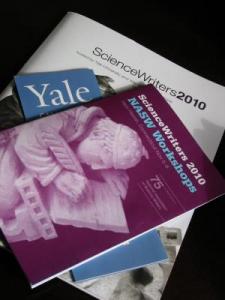By Kara Rogers
If you had $1 to spend on improving science literacy in America, how would you spend it? That was the question posed by Rick Borchelt, an organizer of today's Civics of science session, to panelists Carolyn L. Funk, Jon Miller, and Chris Mooney.
Miller proposed spending half his dollar on improving pre-college science education, with the remainder on adult learning, a small portion of which would be used for science journalism. Mooney suggested spending the whole dollar on creating jobs for science journalists and young scientists, building an army of people devoted to improving public science literacy. And Funk said most of her dollar would go into the education system, with spending divided on efforts to incorporate science standards into elementary and lower-level education and on adult learning and informal adult education, the area where mainstream science journalism has its greatest impact.Although the session raised more questions than it provided answers, the Agronsky & Co. style discussion, as promised, led to some interesting debate about the place of science journalism in science literacy and education in the United States. Science journalism is concerned mainly with delivering information about the latest developments in scientific discovery, and today most science reporting operates within the "just-in-time" model of new media. The cultural importance of science, the future of which could hinge on fitting into the new media scene, was perhaps most entertainingly discussed within the context of music and Rock Stars, a topic introduced by Mooney. Whether science and science journalism would benefit from riding the coat-tails of mass media remains to be seen.
The state of science literacy in America was addressed in data cited by several panelists. Data presented by Miller seemed to suggest that younger Americans, namely those belonging to Generation X, are more science literate than older Americans. Also according to Miller, in a study of science literacy in 34 countries, the United States ranked second best (behind Sweden), with roughly one-quarter of Americans considered science literate.
Of course, measuring science literacy is itself a matter of debate. As Funk pointed out, determining science literacy involves measuring multiple dimensions of scientific understanding. Several of these measures, such as textbook versus practical scientific knowledge, need to be reevaluated. Other measures of science literacy discussed by Funk included conceptual and factual understanding, knowledge of scientific processes, and ability to distinguish between science and pseudoscience.
Pseudoscience is particularly threatening to responsible scientific reporting. People look for scientific information when they need it, and from today's session, it is clear that among the many challenges facing science literacy is the plethora of information, trustworthy and untrustworthy, on the Internet.




